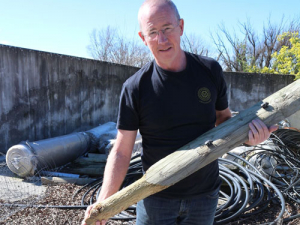Given these are chemically treated, there is little that can be done with them once they break. They can’t be turned into firewood, or burnt onsite (due to chemical issues), dumping them to landfill is not an economic or sustainable answer, so most end up being stockpiled in hidden corners of the vineyard.
If the figure is correct, imagine how many millions of broken posts are currently lying around the region and the country as a whole.
If only there was some way of giving those posts a new lease of life. That was the thought that kept repeating itself in mechanical engineer, turned grape grower, Bruce Forlong’s mind. But instead of just thinking about it, he decided to take action and find a solution – which he has.
The former Aucklander is now the owner of the 120 hectare Tirosh and 30 hectare Shalev vineyards way up the Wairau Valley. When he arrived in Marlborough four years ago, there were 15 thousand broken wooden posts piled up around the Tirosh vineyard.
“I thought there must be a way I can do something with them,” he says, “so I mucked around a bit and came up with a number of machines.”
He quickly realised that the majority of the posts had been broken off at ground level, leaving a substantial length of post still usable. He came up with the idea creating a dowel-like shape at one end of the damaged post, that could then fit into a galvanized steel pipe. The pipe would be driven into the ground the same as a wooden post would, but with a flared open end standing at 600mm above the soil, it would allow for the reshaped post to be slipped inside. The steel provides strength at the point where it is most needed - ground level, there is no potential of leachate as the post is no longer in contact with the soil, and it re-uses a post that would otherwise have to be stockpiled or dumped.
Given his mechanical engineering background, it didn’t take Forlong long to come up with the machinery to do the job. First he developed a machine that flared one end of the imported galvanized steel pipe that will sit above the ground. Then came what can only be described as a giant pencil sharpner that refigures the post end, taking away the sharp corners, without removing the core of the post itself. This rounded end is what is placed into the metal sleeve, which has been driven into the ground by the pole driver he imported from China, and then modified. With 600mm of steel below the ground and 600mm above, it is an extremely strong base, and even harvesters, sprayers or underground cultivators won’t have a serious impact on it. If by chance the recovered post breaks above the sleeve in the future – it can easily be removed and replaced without machinery.
“The idea is whenever I have a breakage, I just have to undo the clips on the post, pull the broken post out and drop a new one in and reposition the clips. It is all very straight forward,” Forlong says.
Being galvanized steel the sleeves should last for years, so once in the ground there is no need to bring the pole driver back in every time a post breaks.
The entire 30 hectares of Shalev vineyard has been developed with the steel sleeves and recycled posts, with each row ending in another innovative design. Again using galvanized steel pipes, the stays and strainers interlock, providing the secure anchor for the rows of posts. Given they are much smaller in diameter than traditional wooden stays and strainers, there is more room for harvesters and tractors to enter at the end of each row.
Having great ideas and putting them into action is one thing, but the success can be a little harder to predict. Forlong didn’t want to say too much about the system he has created and patented, until he was sure it would hold up to the rigours of vineyard life. But having just completed his first vintage on the Shalev block, the results have confirmed his faith in the design. On the eight-hectare block that was harvested for the first time this year, there were only a few broken posts. Compare that with 2000 broken posts on his established, traditionally designed 100-hectare vineyard across the road.
“Over the past three years I have replaced every broken post (on Tirosh) with a steel sleeve and recycled post. I haven’t had to buy any wooden posts, as I have been able to recycle the broken ones. We just pull the old post out, drive a steel sleeve in its place, re machine the broken post, then we pop it back in. It takes no longer to put the metal sleeve into the ground than it does to drive another wooden post. And the cost for the replacement works out about $9 a post, which is cheaper than if I had to turn around and buy new.”
Believing the system could be the answer to an industry problem, Forlong is hoping that this could be implemented on a commercial scale.
If you would like more information, or want to know more, Bruce would be happy to discuss. His email is; This email address is being protected from spambots. You need JavaScript enabled to view it.










